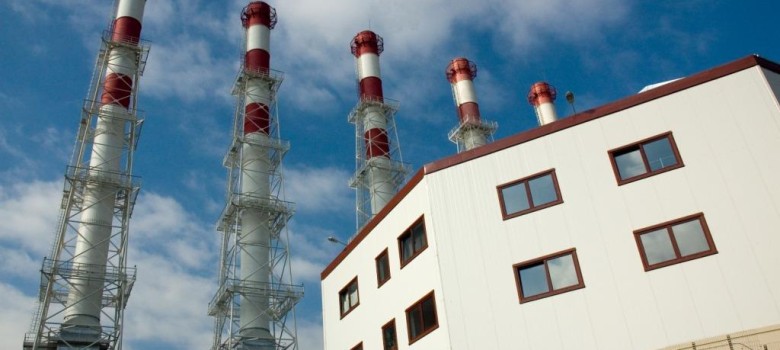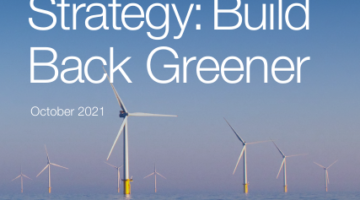
What is cogeneration?
CHP cogeneration (combined heat and power for industry) follows the same processes and principles as micro CHP boilers, but on a grander scale. When a fossil fuel power station produces electricity, it also produces a lot of waste heat. In fact, 65% of the energy potential contained in the fuel turns to heat and only 35% is actually converted to electricity, which shows that there is a large efficiency gap. The heat produced is in the form of steam, which is used to drive the electricity-producing turbines. When you drive past a power station you will have probably have noticed the large cooling towers releasing this steam into the atmosphere, which highlights the wasted heat.
The unique point about CHP Cogeneration is that it captures this steam and reuses it for other purposes, such as providing heating for local districts or towns that are close to the plant. In other cases CHP cogeneration plants can fit in tandem with existing industrial processes; for example the production of sugar beet or providing steam to refineries.
Types of CHP cogeneration
As mentioned in the CHP boilers section, CHP cogeneration is underpinned by a number of different technological processes. The process that creates the energy required can either be a combustion process or a fuel cell chemical reaction. Both of these processes produce the heat and power to ensure they can be used for the purposes of CHP Cogeneration. A summary of the technological processes is in the sub-section below:
Combustion CHP Cogeneration
The structure of CHP cogeneration plants usually takes the form of an external combustion engine, which has been a technology widely used in steam engines. Many fuels can be utilised to produce the heat required including gas, coal, biomass, nuclear and geothermal. The fuel is combusted and this heats water, which is then forced into a pressurised boiler. This heat and pressure feeds the main engine or a turbine, which then rotates. The rotating motion then simply spins a large magnet (main engine) inside a coil of copper wire, known as the generator. This then completes the process of converting mechanical energy into electrical energy.
The difference with CHP cogeneration and other plants is what happens with the steam and heat generated from the boiler that then leaves the system. If the infrastructure is in place, this heat can be released out of this process and potentially pumped to a nearby facility for a different purpose altogether. Some of the secondary activities that heat can be utilised for are, district heating (as discussed above) and to drive newly built water desalination plants.
You can also have CHP cogeneration with power plants that are not primarily there to generate electricity but that are there to support additional industrial processes. For example, a bottoming cycle industrial plant produces high temperature heat for an industrial process such as glass furnacing or metal manufacturing. In addition, a waste heat recovery boiler recaptures waste heat from the manufacturing heating process. This waste heat is then used to produce steam that drives a steam turbine to produce electricity. Since fuel is burned first in the production process, no extra fuel is required to produce electricity. In the 1990s British Sugar built a state-of-the-art CHP plant, using excess heat and electricity to support some of its secondary processes – as well as providing district heating.
Fuel Cell CHP Cogeneration
An emerging CHP cogeneration technology is the fuel cell, where fuel, such as natural gas, is converted to electricity in a chemical reaction rather than a combustion process. Again, let’s talk a little bit first about this fascinating science. First requirement is to have solid oxide fuel cells (SOFC), which are allowed to operate at high temperatures. The fuel cells then on one side chemically interact with a fuel input (LPG, natural gas, hydrogen for example) and on the other side with air. This combined reaction – using an anode and a cathode – and is then able to produce electricity and heat (up to 1000 degrees centigrade).
The development of this technology for CHP cogeneration is ongoing, so that one day it can be used as a standard solution for both businesses and homes. Companies such as Mitsubishi Heavy Industries in Japan are looking at ways of introducing this process alongside conventional combustion processes. An example of how this is utilised could be when a company is enhancing existing gas plants with fuel cell technology, to make sure the levels of efficiency increase. As we have already mentioned, the electrochemical process from fuel cells produces heat, and this is then separately captured and used in a secondary process. For example the heat can be used to create steam, which can then feed a combustion system to create secondary electricity. Any excess heat can be recycled further and used to supply district heating or to enable further industrial processes to take place. These processes and recycling heat for multiple uses, increases plant efficiency, which ensures that as little heat as possible is wasted.
CHP cogeneration industry development
The principles of CHP cogeneration have been around since the 1960s in the UK. For example the Combined Heat and Power Association (CHPA) was set up in 1966 as the District Heating Authority to highlight benefits of district heating, but now it is there to highlight the benefits of taking an integrated approach to heat and power. Industrial and domestic CHP cogeneration generators of electricity can currently make use of the Renewable Obligation Certificates (ROCs) and Feed-in-Tariffs (FiTs) respectively. More on this in the section below, as well as an explanation of the Renewable Heat Incentive (RHI) in more detail.
In the UK, the Immingham CHP cogeneration plant (one of our featured case studies), has been in operation since 2004, producing 1.2GW of electricity, making it one of Europe’s largest CHP cogeneration plants. Some of its uses are as follows: providing steam and electricity to the Humber Refinery, steam to a neighbouring refinery, and power back into the grid.
Now a bit about our neighbours in Europe: CHP cogeneration is already used on a commercial scale in many Scandinavian countries, with 40% of Denmark’s total electricity capacity derived from this source, as is 30% of Finland’s. Germany on the other hand has also made its intentions clear in support of the technology. This signal was made clear since it decided to scale down and decommission the existing civil nuclear power plant project. However other parts of Europe like the UK have a lot of catching up to do to these countries.
Cogeneration CHP UK public policy
The DECC policy is to support measures such CHP cogeneration as well as solar commercial power plants, wind farms and nuclear power to ensure that by 2020 the UK is in a good position to meet its emission reduction targets. The main policy areas that cover CHP cogeneration are summarised below:
Renewable Obligation and Feed-in-Tariffs
ROCs are available to commercial electricity generators of CHP cogeneration, which are usually ones that are able to demonstrate the production of multiple MWh of electricity production (also considered a metric that symbolises the starting point for mass scale consumption). The level of support varies depending on the CHP cogeneration type. For example, if combusting waste CHP cogeneration, then level of support is 1 ROC per MWh. On the other hand, if you are using dedicated biomass fuel with CHP cogeneration, and can demonstrate sustainable fuel supply, then the entitlement increases to 2 ROCs per MWh.
FiTs on the other hand are an initiative to support micro generators of renewable electricity. If you are a small business or a community project (and this is your first time involvement in electricity generation), please note to satisfy the FiT criteria, you need to have a declared net capacity greater than 50kW and up to and including 5MW (2MW for micro cogeneration CHP). Income can be earned both from the generation tariff and the export tariff.
These two policy areas are great incentives if you are looking to invest in renewable CHP cogeneration projects or if you are looking to start up your own renewable CHP cogeneration plant.
Renewable Heat Incentive
The RHI is a payment subsidy (pence/kWh), for heat and hot water generated by households or businesses, using an eligible renewable technology, which includes CHP cogeneration.
District heating
In March 2012, the DECC set out a roadmap for district heating incentives. This has called on improvements to infrastructure around existing power plants and newly built ones to extract some of the excess heat and provide it for local homes and businesses. An apparent lack of investment in infrastructure is to blame for a lack of district heating incentives in this country. Everything in the UK is dug underground from electricity cables, telephony and natural gas distribution. District heating incentives for example would struggle to compete with existing infrastructure in large conurbations, but there appears to be an opportunity for connecting new out of town developments and/ or areas of the country which are currently off-grid.
Examples of some of the CHP cogeneration initiatives that could be implemented in the UK are as follows: heat from gas-fired CHP plants, biomass and biogas, heat pumps, energy-from-waste, solar thermal, excess heat from industrial processes and power stations. These processes are very common in Denmark, and as previously mentioned, are enablers used for helping the process of decarbonisation of the economy.
Installing Micro CHP
Interested in installing a micro CHP boiler? We have scoured the country for the best tradespeople, so that we can make sure we only recommend those we really trust.
If you would like us to find you a local installer to help install micro CHP in your home, just fill in the form below and we will be in touch shortly!












No Comments yet! Be the first one.